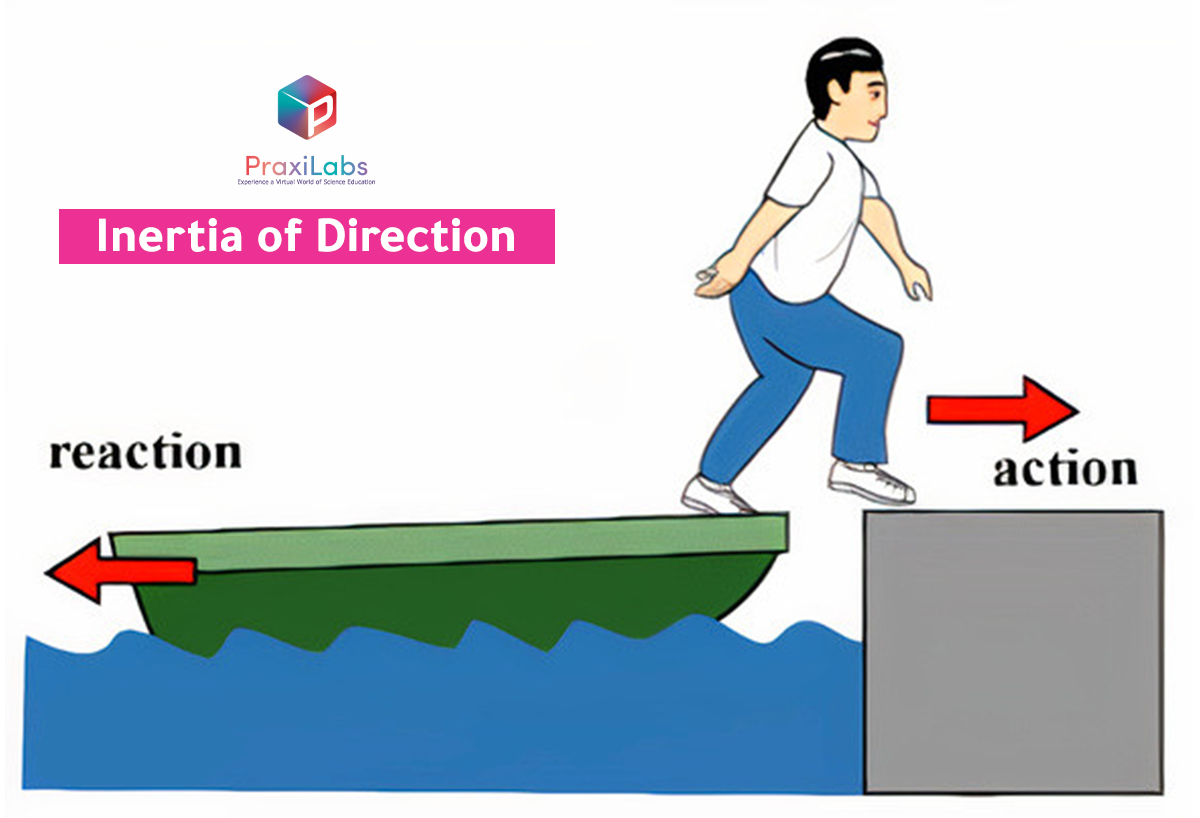Last Updated on June 1, 2025 by Muhamed Elmesery
The principle of inertia is one of the fundamental principles in classical physics that are still used today to describe the motion of objects and how they are affected by the applied forces on them. Inertia comes from the Latin word, iners, meaning idle, sluggish.
In this article, we will discuss inertia, its concept and will focus on the examples of law of inertia in everyday life.
Inertia is a passive property and does not enable a body to do anything except oppose such active agents as forces and torques.
On the surface of the Earth, inertia is often masked by gravity and the effects of friction and air resistance, both of which tend to decrease the speed of moving objects (commonly to the point of rest). This misled the philosopher Aristotle to believe that objects would move only as long as force was applied to them.
try The principle of inertia with best physics virtual lab now

Table of Contents
What is Inertia of Motion?
From Newton’s first law of motion, it is clear that a body has a tendency to remain at rest or in uniform motion. This property of the body is known as inertia. Thus inertia is that property of a body due to which it opposes or resists any change in its state of rest or uniform motion.
The term inertia may be referred to as “the amount of resistance of an object to a change in velocity” or “resistance to change in motion.” This includes changes in the speed of the object or the direction of motion. One aspect of this property is the tendency of things to continue to move in a straight line at a constant speed, when no forces are affecting them.
There are Two Numerical Measures of the Inertia of a Body:
1- The Body Mass:
which governs its resistance to the action of a force.
Mass is the measure of inertia of the body; i.e., greater the mass, greater will be inertia. Thus inertia of a body depends upon its mass.
That is, massive objects possessed more inertia than lighter ones. E.g., Mass of a stone is more than a mass of a rubber ball for the same size. Therefore, the inertia of the stone is more than that of a rubber ball.
Notes:
The inertial mass is a measure of the tendency of an object to resist acceleration. The more mass something has, the more it resists acceleration.
There is also gravitational mass, which as far as we can tell experimentally is identical to inertial mass.
2- The Body Moment of Inertia about a Specified Axis:
The Moment of Inertia is a measure of an object’s resistance to changes to its rotation. Also it can be defined as the capacity of a cross-section to resist bending.
It measures its resistance to the action of a torque about the same axis and it must be specified with respect to a chosen axis of rotation and It is usually quantified in m4 or kgm2.

Moment of inertia
Moment of inertia is the name given to rotational inertia, the rotational analog of mass for linear motion. It appears in the relationships for the dynamics of rotational motion.
The moment of inertia must be specified with respect to a chosen axis of rotation. For a point mass, the moment of inertia is just the mass times the square of perpendicular distance to the rotation axis, I = mr2. That point mass relationship becomes the basis for all other moments of inertia since any object can be built up from a collection of point masses.
Since the moment of inertia of an ordinary object involves a continuous distribution of mass at a continually varying distance from any rotation axis, the calculation of moments of inertia generally involves calculus, the discipline of mathematics which can handle such continuous variables. Since the moment of inertia of a point mass is defined by
The moment of inertia plays the same role in angular motion as the mass in linear motion. It may be noted that moment of inertia depends not only on mass m but also on r².

The Concept of Inertia
The concept of inertia is a fundamental concept in physics. It is bounded with other fundamental concepts as:
- The concept of state: the state of the system can be mechanical (statical, kinematical, dynamical and of deformation), thermodynamic, electromagnetic, etc. The state of a system is defined by the state parameters.
- The concept of interaction.
- The concept of process (transformation): Depending on the nature of the system,. The process consists in the transition of a system from a state to another. Given the causality principle, the process is the effect of interaction.
Depending on the nature of the systems and the nature of the states implied there are many types of processes: mechanical (equilibrium, motion and deformation), electromagnetic, gravitational, chemical, thermodynamic etc.
Visit Our Virtual labs and Experience a Virtual World of Science Education
Try PraxiLabs Virtual Lab For FREE!
Types of Inertia with Examples
-
Inertia of Rest
An object stays where it is placed, and it will stay there until you or something else moves it. The property of a body to oppose any change in its state of rest is known as inertia of rest.
Examples of Inertia of Rest in Our Daily Life
Now we will show some examples of law of inertia

- If an index card is placed on top of a glass with a penny on top of it, the index card can be quickly removed while the penny falls straight into the glass, as The cardboard moves away due to the force applied by the finger but the coin remains at its position due to inertia of rest and hence falls into the glass.
- When a bus or a train starts suddenly, the passenger standing inside it falls backward: It happens because the feet of the passenger being in contact with the floor of the bus come in motion along with the bus but the upper part of the body remains at rest due to inertia of rest. Hence the passenger falls backward.
- When a tree is vigorously shaken, some of the leaves fall from the tree: When the branch of a tree is vigorously shaken, the branch comes in motion as the force is applied on the branch. But the leaves want to remain at rest due to inertia of rest and fall down.
- The carpet is beaten with a stick to remove the dust particles: When carpet is beaten with stick, the carpet comes in motion but the dust particles remain at rest due to inertia of rest.
- A pile of a carom coins remains intact when the lowest coin in the pile is struck quickly by a striker.

-
Inertia of Motion
An object will continue at the same speed until a force acts on it. The property of a body to oppose any change in its state of uniform motion is known as inertia of motion.
Praxilabs Virtual Labs includes a range of online science experiments in physics, chemistry and biology experiments .. Try now!
Get Started Praxilabs For FREE

Examples of Law of Inertia in Everyday Life (Inertia of Motion)
- When the bus stops suddenly, people fall forward. When the driver of a bus brakes suddenly, the lower part of the body comes to rest as the bus comes to rest but the upper part of the body continues to move forward due to inertia of motion. As a result, a forward force is exerted on the body and we fall in the forward direction.
- The electric fan continues to move for a period after the electricity is turned off. The blades of the fan were in motion. Hence, they will take time to come to rest after being switched off.
- If you are on a train and the train is moving at a constant speed, a toy tossed into the air will go straight up and then come down. This is because the toy has inertia like the train and you.
- Luggage is usually tied with a rope on the roof of a bus. When the bus stops suddenly, the luggage kept on the roof may fall from the roof of the bus due to inertia of motion therefore, it is advised to tie any luggage kept on the roof of a bus with a rope.

-
Inertia of Direction
An object will stay moving in the same direction unless a force acts on it. The property of a body to oppose any change in its direction of motion is known as inertia of direction.
5 Examples of Inertia of Direction
- If you jump from a car or bus that is moving, your body is still moving in the direction of the vehicle. When your feet hit the ground, the grounds act on your feet and they stop moving. You will fall because the upper part of your body didn’t stop, and you will fall in the direction you were moving.
- The water particles sticking to the cycle tire are found to fly off tangentially whenever a driver is negotiating a curve; the passengers experience a force acting away from the center of the curve.
- When a bus driver is negotiating a curve on the road, passengers fall towards the center of the curved road. Whenever a driver is negotiating a curve, the passengers experience a force acting away from the center of the curve; it happens due to the tendency of the passengers to continue moving in a straight line.
- When you stir coffee or tea and stop, the swirling motion continues due to inertia.
- Satellites (that establish orbit around the earth) continue on their trajectory due to inertia.
Explanatory Video for Examples of law of inertia in Every day Life
Importance of Inertia in Our Daily Life – Law of Inertia Examples
The inertia of an object enables us to maintain patterns of functioning, maintain relationships, and get through the day without questioning everything. There are many examples of law of inertia that reflect several and important uses:
- The design of safety devices for vehicles, including but not limited to seat belts, that can provide an external force to stop a body’s motion in the event of a sudden change in the physics of the immediate environment.
- In space travel, for example, once a device escapes Earth’s gravity, it will continue on its given trajectory until it encounters another gravitational field or object.
- Space probes can be sent great distances without any additional fuel required other than that needed to “escape” Earth, enact minor navigational changes or land on another object.

Examples of the Law of Inertia in Sports
One of good examples of law of inertia in daily life is the body of a player quickly sprinting down the field will tend to want to retain that motion unless muscular forces can overcome this inertia.
A skater gliding on ice will continue gliding with the same speed and in the same direction, barring the action of an external force.
In gymnastics, athletes are constantly changing their body configuration. By increasing the radius from the axis of rotation, the moment of inertia increases thus slowing down the speed of rotation.
If an athlete wants to increase the speed of rotation, then they must decrease the radius by bringing the segments of the body closer to the axis of rotation thus decreasing the radius and moment of inertia.
Limitations of Law of Inertia
There are many limitations of the law of inertia, as this law was given three and a half centuries ago. Some of the limitations of this law are:
- Limited to Non-Relativistic Speeds: The Law of Inertia is only valid for objects moving at non-relativistic speeds i.e., speed not closer to the speed of light. At very high speeds, close to the speed of light, the laws of physics change, and the concept of inertia is no longer applicable.
- Only Applicable in Inertial Frames: The Law of Inertia is only applicable in inertial frames of reference, which are frames that are not accelerating. In other words, the Law of Inertia doesn’t hold for non-inertial frames of Reference.
- Neglects Friction and Other Forces: The Law of Inertia assumes that there are no external forces acting on an object, but in reality, there are always some forces acting on an object. Friction, air resistance, and other forces can significantly affect the motion of an object and are not taken into account in the Law of Inertia.
- Applicability at Microscopic Level: As the size of the particle goes to the microscopic, atomic, or subatomic scale, then also the law of inertia fails to hold as there are various other forces that come into play that don’t have any effect on everyday objects.
Source: GeeksforGeeks (2024) Inertia: Law of inertia, examples, and faqs, GeeksforGeeks. Available at: https://www.geeksforgeeks.org/law-of-inertia/ (Accessed: 04 August 2024).

Unleashing Innovation: Dive into Mechanical Physics with PraxiLabs!
PraxiLabs the digital science lab enable you to conduct various laboratory experiments in physics, chemistry, and biology online anytime and anywhere.
Try the virtual labs in mechanics that explain Newton’s laws of motion and more:
- Free Fall
- Motion on Inclined Surface
- Ballistic Pendulum
- Newton’s Second Law
Create your free account and try our virtual labs in mechanics!

Inertia Demystified: FAQs Illustrated with Examples
What is Inertia Definition?
Inertia refers to “resistance to change in motion.” or “the amount of resistance of an object to a change in velocity” This includes changes in the direction of the object or the speed of motion.
In simple words, inertia is the property that describes the tendency of objects to continue to move in a straight line at a constant speed, when no forces are affecting them.
There are 3 types of Inertia:
- Inertia of rest.
- Inertia of motion.
- Inertia of direction.
What is Law of Inertia?
The law of inertia is Newton’s first law, which states that “An object at rest will stay at rest, and an object in motion will stay in motion unless acted on by a net external force”.
This means that if a body is moving at a constant speed in a straight line or at rest, it will keep moving in a straight line at constant speed or remain at rest unless it is acted upon by an unbalanced force.
What are 5 examples of the law of inertia?
- Satellites that establish orbit around the ُEarth, keep moving in a circular motion.
- The electric fan continues to move for a period after the electricity is turned off.
- Falling forward in a bus when sudden breaks are applied.
- A skater gliding on ice will continue gliding with the same speed and in the same direction, barring the action of an external force.
- An athlete taking a short run before a jump.
What are the 10 examples of inertia of direction?
- Jumping from a moving car or bus. When your feet hit the ground, the grounds act on your feet and they stop moving. You will fall because the upper part of your body didn’t stop (still moving in the direction of the vehicle), and you will fall in the direction you were moving.
- When a bus driver is negotiating a curve on the road at high speed, passengers fall towards the center of the curved road.
- The mud from the wheels of a moving vehicle flies off tangentially.
- Stirring coffee or tea and then stopping, the swirling motion continues due to inertia.
- Bags and things on the bus can be thrown sideways during a turn (if not tied) due to inertia of direction.
- Satellites continue on their trajectory due to inertia.
- On flowing water, if you place a rotating wheel ,particles of water fly of tangentially due to inertia of direction.
- When you turn a bicycle, your body naturally wants to continue moving in a straight line.
- During swimming, when you change your direction, your body initially tends to keep moving in the direction you were going due to inertia of direction, requiring you to adjust your stroke to change course.
- When a skateboarder turns, their body tends to continue moving in the direction he was initially moving, requiring them to adjust his balance and lean to maintain equilibrium.
What is an example of inertia in real life?
If you jump from a car or bus that is moving, your body is still moving in the direction of the vehicle. When your feet hit the ground, the ground acts on your feet and they stop moving. You will fall because the upper part of your body didn’t stop, and you will fall in the direction you were moving.
What are 5 examples of Newton’s first law?
- The concept of car airbags.
- The motion of a ball falling through the atmosphere.
- The motion of a model rocket launched into the atmosphere.
- A book on the table stays in place unless it is dislodged.
- While riding a bike, you fly forward away from the bike when you hit a rock or anything else that suddenly stops the bike.
You can try PraxiLabs virtual lab for online Physics experiments … Subscribe now and select your plan
 PraxiLabs A virtual world of science
PraxiLabs A virtual world of science





